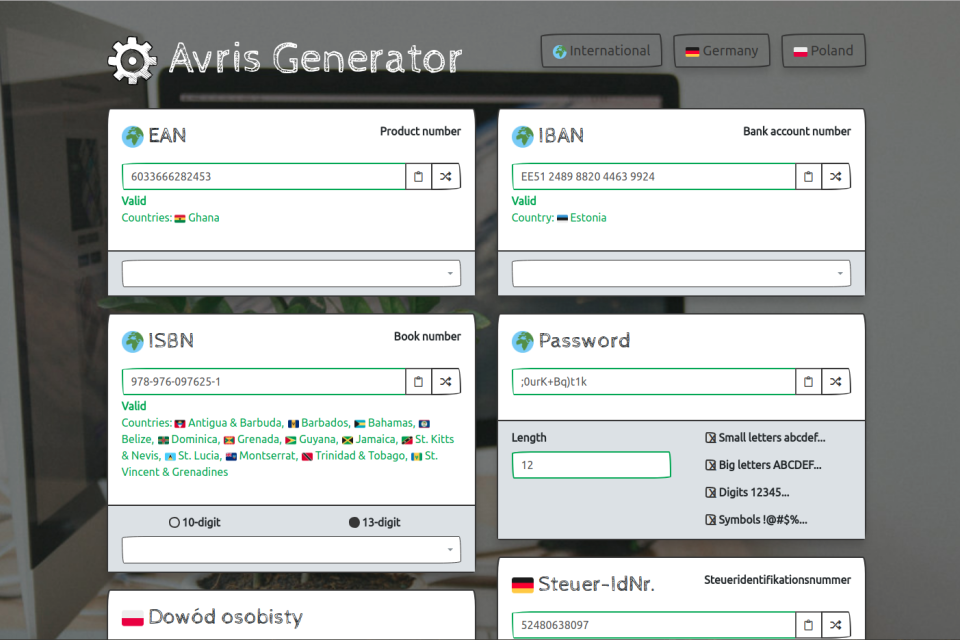

setFormNotification("Iban is invalid.", "2", "IbanValidator") I always use this npm iban package and I love how you can open up the command line and just: On to the actual validation part of creating the iban validator component. Local debugging of the PowerApps Component Framework Iban Validator and validation The api used to get your image does not return a resource. However images you want to include to your component will not load. This work great for actually testing your logic. You can debug the component on your local machine where you can test your component. Just so you know what happens behind the scenes. I recommend checking that out, but only after you’ve manually followed the steps once. Luckily the community quickly responds and added a XrmToolBox plugin. There are however a lot of steps involved to publish and test your app inside a Dynamics environment. I do not have a lot of Node experience, but most of the commands are pretty self-explanetory.
#Iban validator api install#
To install the tools and create the framework for my first component I followed the steps in this excellent blog post by Debajit Dutta. PowerApps Component Framework – IBAN Validator in action Installing PowerApps Component Framework
#Iban validator api code#
I created an IBAN validator. This is validation we build for a lot of customers, so this is a good component to start with.Ĭurrently my solution uses deprecated code (the Xrm.Page object), so use with caution. Last but not least, this framework will come to canvas apps soon.

It promises to provide us with the same API’s the Microsoft development team uses. No longer are we restricted by IFrame’s where we have little connection to the app. What excites me about this framework is that it provides developers with a native way to integrate development into Model-driven PowerApps / Dynamics 365 Customer Engagement. With this configuration, the php-fpm service is able to ping the mock-iban-validator service, and in addition to that, is able to do something like the following $ curl mock-iban-validator.My first blog post is about my experience with the PowerApps Component Framework so far. Note that inside the $PWD/docker/mock-server/iban-checker folder, a file called expectations.json is stored containing all the needed expectations. mock-iban-validator: image: mockserver/mockserver networks: internal: aliases: - mock-iban-validator.internal volumes: - $PWD/docker/mock-server/iban-checker/:/config/ environment: SERVER_PORT: 1080 MOCKSERVER_INITIALIZATION_JSON_PATH: /config/expectations.json # - # Networks # - # networks: internal: php-fpm: networks: internal: aliases: - php-fpm.internal. Then what we want to do is to add a MockServer instance for the IBAN validator service transforming the configuration to this one version: '3.8' # - # Services # - # services: nginx. Let’s suppose we have a PHP application with a Docker Compose cluster defined on the docker-compose.yml like this version: '3.8' # - # Services # - # services: nginx. More examples of expectations can be found on the official documentation page.Īs previously said, the MockServer can be found in different forms yet my preferred one is through the official Docker image. Obviously, this is a very simple example just to show the main idea behind the usage of this tool. With this expectation defined the mock-server will reply as if we would interact with the real service. So, we will need to define an expectation like this Probably we will execute an HTTPs request similar to the following one GET Authorization: Bearer api-key I’m in love with examples, I think they’re the best thing to let someone understand concepts, so let’s go back to our application that needs to validate an IBAN. So, first thing first, let’s give some details about this tool.Īs briefly explained, the MockServer can be configured by defining expectations, which are blocks of request-response. To do so different approaches can be adopted, starting from just validating the IBAN format (a weak check), up to the real-time validation interacting with a third-party service like this one. Suppose that you’re dealing with an application, that among other things, needs to validate an IBAN in different scenarios, for instance, while creating a new user.

In this article, I’ll explain the strategy that I’ve found effective to mock external services with a tool called MockServer while doing integration testing. Yet, we need an effective way to be able to write and execute automated tests for our applications in an isolated environment, because, always remember that… Current application development is more and more subjected to the use of third-party services for a variety of reasons, to speed up the development process, to rely on some robust and reliable solutions and many other reasonable reasons.


 0 kommentar(er)
0 kommentar(er)
